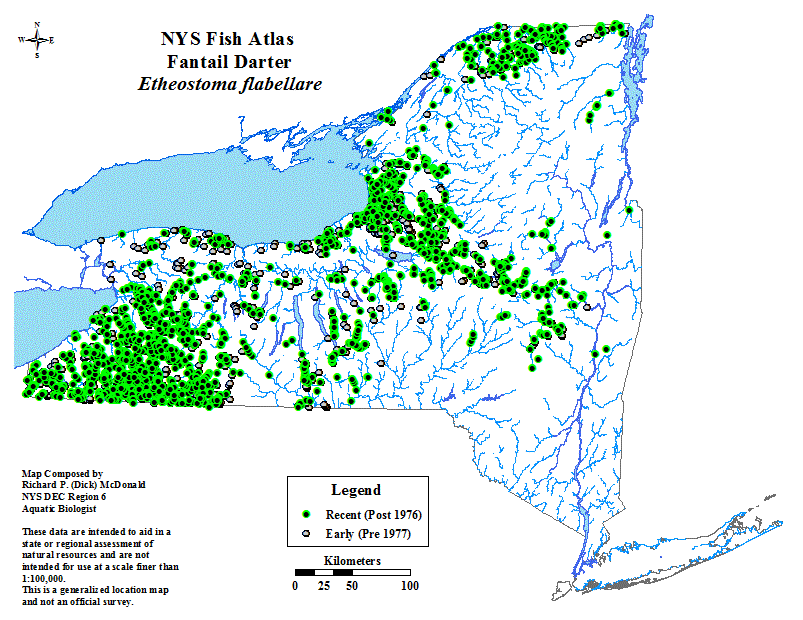
Fantail Darter (Etheostoma flabellare)
This species occurs from southern Minnesota and Wisconsin, east through the southern Great Lakes (excluding Lake Superior) to southern Quebec and New York State. It ranges south in the Mississippi Valley to the Ozarks of eastern Kansas, eastern Oklahoma, Missouri, and northern Arkansas. In the Tennessee basin, it reaches northern Mississippi and Alabama. On the upland parts of the Atlantic slope, it ranges from northern South Carolina to southern New York. In New York, it occurs in the western and northern parts of the state but is absent from the Lower Hudson.
Fantail darters occur in riffle areas of streams where there are cobbles and gravel. They are especially abundant in streams where there are chunks or slabs of limestone or shale.
The life history of the fantail darter was studied in Black Creek, near Rochester. Spawning occurred in late April to mid-June after the water temperature reached 60 F. Males moved onto the spawning grounds, areas of moderate current above riffles, and selected their nest sites. These were usually flat rocks with a space about one-half inch high beneath them. A male cleaned his nest by wriggling his body into the crevice. Other males were chased away from the site but a female was enticed into the nest by bunting and prodding. After circling each other, the female rolled over to apply her vent region to the roof of the nest and the male assumed a head to tail position, rolling on his side and twisting the posterior part of his body to bring his vent region into proximity with that of the female. The eggs were deposited in groups of 1 to 3 at intervals of 1 to 3 minutes until about 45 eggs had been deposited. Both parents vibrated vigorously as the eggs were released and fertilized. The female remained inverted but the male turned upright between spawning episodes. After spawning the female left and the male enticed other females to spawn until the nest contained as many as 562 eggs.
The male guarded the nest, periodically grooming the eggs with the fleshy tabs on his dorsal spines, until the eggs hatched: 30 to 35 days at 63 to 68 F, 21 days at 70 F, and 14 to 16 days at 74 F.
Dissections suggested that each female spawned 5 times and that a new crop of eggs developed by November. A 33-mm female contained 128 eggs; a 49-mm female contained 422 eggs. The eggs averaged 2.3 mm in diameter. By fall, the young averaged 30 mm and they reached sexual maturity by the following summer.
The winter food of the fantail darter was studied in Vandermark Creek, a headwater tributary of the Genesee River in Allegheny County. It consisted of a variety of insects, including mayflies, caddisflies and dipterans, and copepods, as well as cladocerans, amphipods, isopods, hydrachnids, and gastropods. Such groups, however, made up only a small part of the diet. Medium-sized fish ate the greatest variety of food. Young fantail darters ate mayfly and midge larvae whereas larger fish ate mayfly and midge larvae and other larger insects. In Lake Erie, they also ate amphipods.
Distribution of fantail darters in NY state.
An image of the fantail darter is also available for download.
The above species description was taken out of "The Inland Fishes of New York State" by C. Lavett Smith, published by the New York State Department of Environmental Conservation, 1985.
